Every so often when you’re looking through a book of old New England recipes, you’ll find one that calls for the common cracker. Well, there are plenty of common crackers around. Saltines come to mind.
But the common crackers these recipes call for are actually a specific type of common cracker. And these days, they’re anything but common.
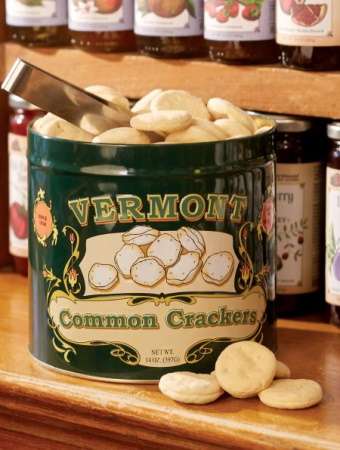
If you dropped back in time, say 30 years, you’d know exactly what the recipe needs. Well into the 1970s, the common cracker was ubiquitous throughout New England.
But to get the full picture, you’d need to step back in time a bit further, to the days when fresh bread was not easy to buy and before science took over the business of baking. With preservatives and cellophane and cardboard packaging, today you can commonly eat crackers made anywhere in the world.
But in the early 1800s, that wasn’t the case. Baking science hadn’t evolved so, and the common cracker solved a problem for hungry families needing a staple that would keep for months.
Inventor of the Common Cracker
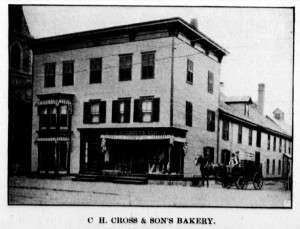 If you want to figure out who invented the first common cracker, you probably won’t have any luck. They went by many names and many bakers produced them, with small variations in size. The Boston Cracker in Massachusetts, the Portland Cracker in Maine, the Montpelier Cracker in Vermont, and so forth.
If you want to figure out who invented the first common cracker, you probably won’t have any luck. They went by many names and many bakers produced them, with small variations in size. The Boston Cracker in Massachusetts, the Portland Cracker in Maine, the Montpelier Cracker in Vermont, and so forth.
American crackers, themselves, first came into existence in Newburyport, Mass. — or so the story goes– in the bakery of Theodore Pearson. There he created pilot biscuits.
Sailors, soldiers, explorers and travelers have carried some variation of cracker with them for centuries, as far back as you can imagine. The Newburyport version of this was called hard tack (among other things).
Hard Tack
Hard tack consists of an unleavened water and flour baked to within an inch of its life. It will last virtually forever. Hard tack produced for the War of 1812 was stored and then brought out for use in the Civil War, for example, none the worse for wear. Soldiers and sailors preferred it only slightly to starvation.
But hard tack soon gave rise (forgive the pun) to more elegant crackers for domestic use. The addition of yeast, a rising period of 24 hours (and more) and a long period of kneading, followed by baking and drying, resulted in a puffy white cracker with a hard thick outer shell. Voila! The common cracker.
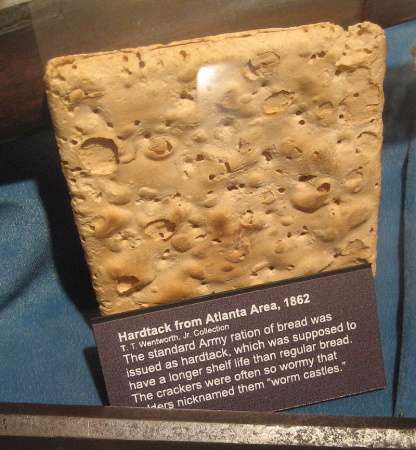
Preserved hardtack from U.S. Civil War, Wentworth Museum, Pensacola.
The ingenious yankees had dozens of uses for them. Many involved mashing. They commonly used them as thickeners for soup and chowder or mashed and eaten with milk. Later, they split them, buttered them, toasted them and gave them all sorts of toppings. And when potatoes began to take over the chowder, the crackers shifted to the side for crumbling in just before eating.
The folks at The Food Timeline suggest Artemus Kennedy, a baker in what is now Arlington, Mass., originated the common cracker. Kennedy, their research suggests, began baking the crackers at his bakery founded in 1805. He rode around the nearby country on horseback selling them. But no one knows where he got the idea for them.
Early Bakers
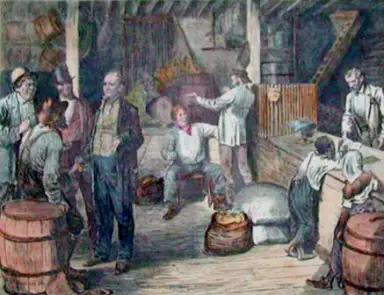 Another early baker who dabbled with the cracker was Josiah Bent, founder of the G.H. Bent company in Milton, Mass., in 1801. The company earned a reputation for making water crackers, which Bent prized for their ability to travel well on sea voyages. Bent’s water crackers are smaller than the common cracker, but he made other products as well. Bent definitely made a lot of hard tack for the government, as did Pearce, and the company revived that recipe for Civil War reenactors a century after the war itself ended.
Another early baker who dabbled with the cracker was Josiah Bent, founder of the G.H. Bent company in Milton, Mass., in 1801. The company earned a reputation for making water crackers, which Bent prized for their ability to travel well on sea voyages. Bent’s water crackers are smaller than the common cracker, but he made other products as well. Bent definitely made a lot of hard tack for the government, as did Pearce, and the company revived that recipe for Civil War reenactors a century after the war itself ended.
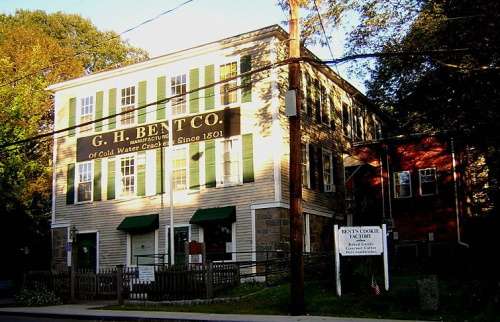
The G.H Bent factory in Milton, Mass.
Perhaps the best known of the common cracker makers was Charles Cross of Montpelier, Vt., and his tireless horse. Charles and his brother Thomas, originally from New Hampshire, founded Cross Bakers in 1828. The business continuously operated for 151 years, evolving into C.H. Cross & Sons before going bankrupt in 1979. Then the firm and its Cross Crackers moved to Claremont, N.H.
In the early days, Cross used a horse-powered treadmill to run the machinery for his bakery. His horse alternated jobs, one day powering the treadmill, the next hauling crackers for delivery. Over time, Cross grew to have a crew of salesmen traveling throughout New England selling his crackers to stores.
But in his earliest days, Cross packed up the crackers and displayed them in barrels. And this is probably how we most associate with common crackers: stored in a barrel that served as a centerpiece of the country store where they were sold. Visitors to the store would be invited to pull up a seat, crack open a cracker and put a piece of cheese on it. In this setting, men resolved the issues of the day, shared news and settled arguments.
Then the barrels disappeared. And as the humorist John Gould wrote, “everything has been on the skids since the common cracker declined.”
Julia Child
The common cracker had a new lease on life given to it by Julia Child, who gave them her stamp of approval for use with chowder. She became rather famously obsessed with cracking the recipe, which she eventually did.
Should you need a common cracker today, there are two companies still selling them: the aforementioned G.H. Bent, known as the Bent Cookie Factory, which has continuously operated since 1801; and Vermont Common Foods, which wholesales them and has a nice collection of recipes for how to cook with them. The company acquired the Cross cracker equipment, which it uses to make them today.
You can order the Vermont Common Cracker from the Vermont Country Store. Click here. This story was updated in 2021.
Images: GH. Bent Co. By Jameslwoodward – Own work, CC BY-SA 3.0, https://commons.wikimedia.org/w/index.php?curid=7907262. Hard tack By Infrogmation of New Orleans – Photo by Infrogmation, CC BY-SA 3.0, https://commons.wikimedia.org/w/index.php?curid=4615956
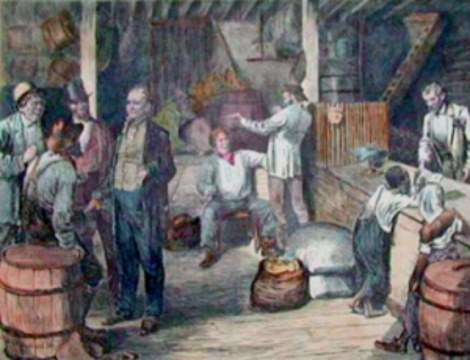
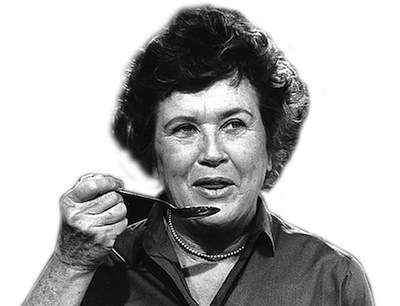

12 comments
We always go on a hunt for these over the holidays. Common Cracker pudding is a family favorite.
Vermont country store for common crackers?!
WESTMINSTER CRACKERS!! no longer made in Westminster, MA – now made in VT but still carry the Westminster cracker bldg. on their logo.
My father also lamented the decline of the common cracker. He liked to break them up into a bowl of milk.
Vermont Common Crackers are available at Market Basket in Wilmington,MA
They are available on Amazon
it is hard to believe,but i have a recipe for the original common cracker.it is one you can’t find anywhere because it is a recipe thats legally owned by vermont cracker co.we use them to thicken our soups and chowders,as well as in more of our cooking,it is a great addition to meatloaf as well.
Would you send me the recipe for common crackers. Common cracker were on “state plate” Tv show.
[…] to many fine international cuisines. He liked fruit, and was known to say, "Five or six small crackers and a glass of water give me a sumptuous […]
[…] the country has ever had, Adams was simple in most of his tastes, often content to dine on crackers in a city that teemed with bon vivants. Adams’ personal style was reflected in his […]
[…] crackers were also known as common crackers, and were often eaten with cheese. They were not the only products in barrels; others included […]
[…] presidents the country has ever had, Adams was simple in most of his tastes. He often dined on crackers in a city teeming with bon vivants. He was inaugurated in a black, homespun suit with full-length […]
Comments are closed.